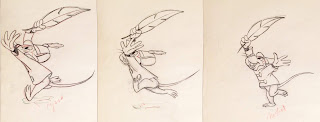Eight original production animation drawings in red, green, and graphite pencils of Timothy Q. Mouse from "Dumbo," 1941, Walt Disney Studios; Numbered 32, 34, 35, 36, 37, 38, 39, and 40 in pencil lower right; Production stamps lower left; Size - Timothy Mouse (Largest Image): 6 1/4 x 6", Sheets: 10 x 12"; Unframed.
“Dumbo! Look! Have I got it! The magic feather! Now you can fly!”
―Timothy Q. Mouse
The Walt Disney full length feature film "Dumbo," released in 1940, introduced to the world one of the greatest characters in the Disney pantheon, Dumbo the flying elephant! Dumbo was the only character in the film who never uttered a single word, and yet he is one of the most remembered Disney stars. All of his feelings were conveyed through body movements and facial expressions. The extraordinary animation skill needed in order to do this with a human, but in this case a baby elephant, can not be underestimated.
Original production animation drawing of Timothy Q. Mouse.
The Disney Studio animation artists were still fairly new to feature animation, having only started in 1937 with "Snow White and the Seven Dwarfs." The film prior to "Dumbo" was "Fantasia," with one of the most successful sequences being "Night on Bald Mountain." Here again, the main character Chernabog, a huge winged devil, sitting on top of a mountain, commanding the undead below, and never uttering a single word; made a huge impression on the viewing public.
Original production animation drawing of Timothy Q. Mouse.
Original production animation drawing of Timothy Q. Mouse.
The
Disney animator Vladimir "Bill" Tytla created the devil-giant for
"Fantasia's" "Night on Bald Mountain," and for the next film he was
given the task of animated the film's star, Dumbo. He said:
"I gave him everything I thought he should have," said Tytla. "It just happened. I don't know a damn thing about elephants. It wasn't that. I was thinking in terms of humans, and I saw a chance to do a chracter without using any cheap theatrics. Most of the expressions and mannerisms I got from my own kid. There's nothing theatrical about a two-year-old kid. They're real and sincere- like when they damn near wet their pants from excitement when you come home at night. I've bawled my kid out for pestering me when I'm reading or something, and he doesn't know what to make of it. He'll just stand there and maybe grab my hand and cry... I tried to put all those things in Dumbo."
Original production animation drawing of Timothy Q. Mouse.
"I gave him everything I thought he should have," said Tytla. "It just happened. I don't know a damn thing about elephants. It wasn't that. I was thinking in terms of humans, and I saw a chance to do a chracter without using any cheap theatrics. Most of the expressions and mannerisms I got from my own kid. There's nothing theatrical about a two-year-old kid. They're real and sincere- like when they damn near wet their pants from excitement when you come home at night. I've bawled my kid out for pestering me when I'm reading or something, and he doesn't know what to make of it. He'll just stand there and maybe grab my hand and cry... I tried to put all those things in Dumbo."
Original production animation drawing of Timothy Q. Mouse.
Original production animation drawing of Timothy Q. Mouse.
Certainly the greatest theme of "Dumbo" was the wonderful friendship between the mute baby elephant Dumbo and his unlikely friend, a mouse name Timothy. Various Disney animators were involved with the creation and animation of Timothy Q. Mouse including Fred Moore, Wolfgang Reitherman, and Ward Kimball. Edward S. Brophy was an American character actor, voice artist, and comedian; and he provided the voice for Timothy Mouse even though he was not credited in the film for the role.
Close up of the Timothy Q. Mouse original production animation drawings.
Close up of the Timothy Q. Mouse original production animation drawings.
This is a rare and wonderful set of eight original production animation drawings of Timothy Q. Mouse holding the "Magic Feather." The Feather had been plucked by Jim Crow from one of his crow comrades as a way to boost Dumbo's confidence that he could really fly. Timothy is eyes and mouth open, running, and holding the "Magic Feather" in his right paw. A spectacular large image from this pivotal point in the film, and a great addition to any vintage Walt Disney animation art collection!
#Dumbo #Disney #WaltDisney #VladimirTytla #BillTytla #animation #animationcel #cel #animationart #untitledartgallery #animationdrawing #productiondrawing #productioncel #productionbackground #TimothyMouse #EdwardBrophy #TimothyQMouse #FredMoore #WolfgangReitherman #MrsJumbo #BabyMine #TimothyMouse #Courvoisier #CourvoisierGalleries






























